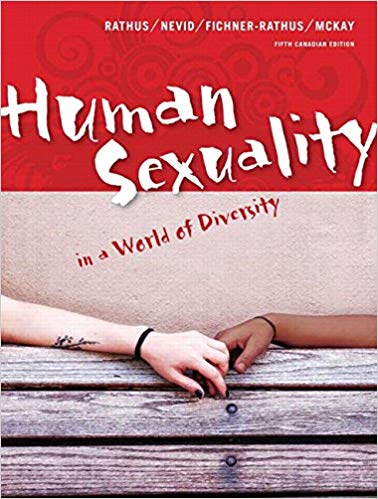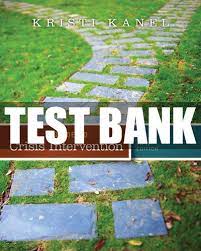Description
Test Bank For Human Sexuality in a world of diversity 5th Canadian Edition By Rathus
Chapter 05
1) Sexual differentiation means
A) the process by which males and females develop distinct reproductive anatomy.
B) the complex behavior patterns deemed masculine or feminine in a particular culture.
C) differences in the preconceptions held regarding men and women.
D) the process by which children distinguish between expectations of girls and of boys.
Answer: a
Diff: 2 Type: MC Page Reference: 126 Skill: Recall
2) A fertilized ovum is called a
A) formation.
B) zygote.
C) embryo.
D) fetus.
Answer: b
Diff: 2 Type: MC Page Reference: 127 Skill: Recall
3) In the fertilization process, chromosomes from each parent combine to form
A) 23 chromosomes.
B) 23 pairs of chromosomes.
C) 46 pairs of chromosomes.
D) 92 chromosomes.
Answer: b
Diff: 1 Type: MC Page Reference: 127 Skill: Recall
4) During the first six weeks of development, embryonic structures of both genders resemble
A) primitive male structures.
B) primitive female structures.
C) both male and female structures.
D) neither male nor female structures.
Answer: b
Diff: 2 Type: MC Page Reference: 127 Skill: Recall
5) Sexual differentiation of gonads, genital ducts, and external genitals begins about
A) seven weeks after conception.
B) nine weeks after conception.
C) twelve weeks after conception.
D) fifteen weeks after conception.
Answer: a
Diff: 2 Type: MC Page Reference: 127 Skill: Recall
6) The twenty-third pair of chromosomes determines
A) sex.
B) eye colour.
C) height.
D) weight.
Answer: a
Diff: 1 Type: MC Page Reference: 127 Skill: Recall
7) An embryo at five to six weeks is, on average,
A) 1/2 to 1 cm long.
B) 1 to 2 cm long.
C) 1/8 cm long.
D) 2 to 3 cm long.
Answer: a
Diff: 2 Type: MC Page Reference: 127 Skill: Recall
8) The basic blueprint of the human embryo is
A) male.
B) neither male nor female.
C) female.
D) both male and female.
Answer: c
Diff: 1 Type: MC Page Reference: 127 Skill: Recall
9) Which of the following statements is true?
A) The “natural course” of embryonic development is male.
B) The absence of a Y chromosome alters the developmental course from male to female.
C) The presence of only one X chromosome, instead of two, will result in a male fetus.
D) The presence of a Y chromosome alters the developmental course from female to male.
Answer: d
Diff: 2 Type: MC Page Reference: 127 Skill: Applied
10) If it weren’t for ________, we would all develop__________.
A) androgens; female external organs
B) estrogen; male external organs
C) progesterone; female external organs
D) FSH; male external organs
Answer: a
Diff: 1 Type: MC Page Reference: 128 Skill: Recall
11) In male sexual differentiation, each Wolffian duct differentiates into
A) the penis.
B) an epididymis, vas deferens, and seminal vesicle.
C) each of the two testes.
D) the scrotum.
Answer: b
Diff: 2 Type: MC Page Reference: 128 Skill: Recall
12) Differentiation of fetal tissues into external male genitals occurs under the influence of
A) testosterone.
B) Müllerian-inhibiting substance (MIS).
C) H-Y antigen.
D) dihydrotestosterone (DHT).
Answer: d
Diff: 2 Type: MC Page Reference: 128 Skill: Recall
13) In female sexual differentiation, which statement is correct?
A) The Müllerian ducts develop into the fallopian tubes, the uterus, and the upper two-thirds of the vagina.
B) The Müllerian ducts develop into the fallopian tubes and the Wolffian ducts develop into the uterus.
C) The Müllerian ducts degenerate and the Wolffian ducts develop into the labia majora, labia minora, and the vaginal opening.
D) The Wolffian ducts develop into the fallopian tubes, the ovaries, and the vagina.
Answer: a
Diff: 3 Type: MC Page Reference: 129 Skill: Applied
14) Which one of the following examples demonstrates Turner’s syndrome?
A) Rick is sterile and was born with XXY-patterned chromosomes.
B) Beth was born with XX chromosomes and identifies as male.
C) Shane possesses both testicular and ovarian tissues.
D) Pat has one X chromosome and has never developed breasts.
Answer: d
Diff: 2 Type: MC Page Reference: 129 Skill: Applied
15) In males, the testes develop in the
A) scrotal sac.
B) inguinal canal.
C) abdominal cavity.
D) vas deferens.
Answer: c
Diff: 1 Type: MC Page Reference: 129 Skill: Recall
16) Testosterone is a type of
A) gonad.
B) androgen.
C) gene.
D) chromosome.





Be the first to review “Test Bank For Human Sexuality in a world of diversity 5th Canadian Edition By Rathus”